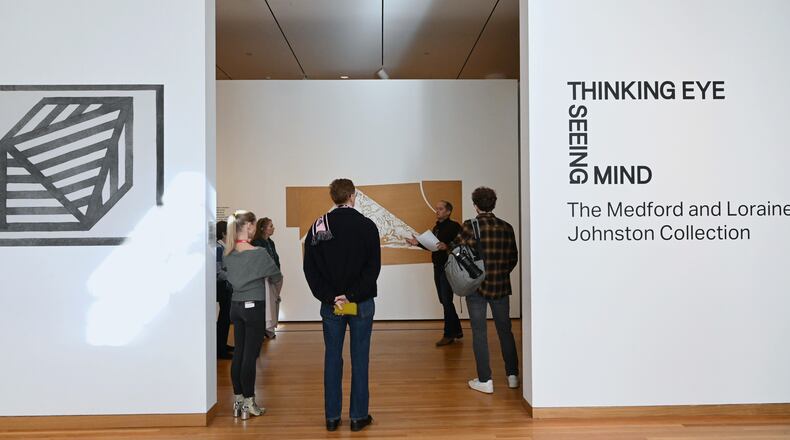Medford Johnston, 83, held his wife Loraine’s hand and shielded her from the rain as the couple sauntered up to the High Museum of Art from their Midtown home across the street on a freezing, wet day in January. The couple was visiting the museum to view their own collection of art being installed on white walls inside — a collection they had amassed with zeal and passion over 50-plus years of marriage and had not once seen displayed together in its entirety.
Seeing their carefully sought artworks numbering roughly 85 pieces was a milestone. It has been almost six decades since the couple got married in their mid 20s and began collecting. It has been almost eight decades since Loraine first crushed on the cute boy Med (as she lovingly calls him) when she was just 5 years old on the playground of their elementary school in Decatur, where they both grew up. It has been 28 years since Medford retired from a three-decade career as an art professor at Georgia State University.
Last year, the couple gifted their collection now comprising the exhibition “Thinking Eye, Seeing Mind: The Medford and Loraine Johnston Collection,” to the High, hoping their labor of love would leave a legacy beyond themselves and offer visitors a peek into an era of artmaking from their own generation.
“We didn’t have children by choice,” Medford said. “The collection is what we leave behind.”
Credit: HYOSUB SHIN / AJC
Credit: HYOSUB SHIN / AJC
The grouping narrowly focuses on works produced by the vanguard of American contemporary artists in the late 1960s and ‘70s, a postwar time when creatives played with rule-breaking, abstraction, minimalism and experimentation. There are line drawings, ink blotches, geometric arrangements of fabric and blocks of color. “Thinking Eye, Seeing Mind” includes works by Elizabeth Murray, Martin Puryear and Stanley Whitney, to name but a few.
Each piece carries a story the Johnstons can wax on about how they came across the artist, the context in which the art was created, or the lengths they personally went to to acquire the work.
They remember first seeing the work of Alan Shields, the mixed-media artist known for blurring the lines between sculpture, painting and textiles, at New York’s Paula Cooper Gallery while on their honeymoon in the heat of August when Loraine was 26 and Medford 27.
“It was so fantastic, and we’d never seen anything like it,” he remembers.
After they saw it, Medford cut out an ad for a gallery in Houston, Texas, that carried some of Shields’ art. Medford got up the nerve to write a letter to the gallery offering to pay for a piece in installments.
“It was before the internet and before 800 numbers,” he remembers. “I wrote this letter … this is how naive I was. Really and truly … but I got this wonderful handwritten note back. And it started this incredible 50-year rapport with Fredericka [the gallery owner].”
When an Elizabeth Murray artwork was being put up for a charity auction by Franklin Furnace, an exhibition space in New York, Medford was crushed he couldn’t go because he was teaching in Atlanta. In his stead, he sent Loraine. She took a girlfriend on the impromptu mission with not a dollar more than the minimum bid of $1,000. When the young women tied with another bidder, they convinced the seller to grant it to them.
“If looks could kill,” Loraine recalled, laughing.
Credit: Courtesy of Matthew Marks Gallery, New York.
Credit: Courtesy of Matthew Marks Gallery, New York.
The couple’s stories could fill a book. So could the knowledge Medford has accumulated. He knows, for instance, how the artist Peter Young spent time in the Amazon rain forest with no traditional art supplies, which influenced the organic and tribal aspects of the minimalist’s weirder work.
“He was just a really exotic human being … we have no idea what the two pieces we have are painted on. It could be toilet paper … it could be anything. It’s very translucent,” the collector said.
Medford knows why three works in the collection by Shields are two-sided: because the artist worked in theater and everything needed to be viewed from multiple angles.
Her husband’s fascination and penchant for art has been a quality Loraine has admired since college. Her parents were scientific, not artistic. When she was attending Emory University, she loved an art history course she took, but was surrounded by premed students who would rather flunk than attempt to draw negative space.
Medford was different. “He knew so much about everything that was going on in art,” she said. “He’s brilliant that way … Even if I didn’t give a fig for him, he was brilliant that way.”
Though and worked in finance for much of her career, Loraine’s innate affinity for art was independent of Medford’s. She still gets emotional when she recalls the first time she saw a retrospective of Piet Mondrian’s work when she ditched a business meeting solo in New York.
“Every room was like a gasp … [I saw] ‘Broadway Boogie Woogie’ and I just burst into tears. I couldn’t help it,” she said.
Credit: Courtesy of Medford and Loraine Johnston
Credit: Courtesy of Medford and Loraine Johnston
The Johnstons’ shared pursuit of art is a tie that binds them. Their individuality, however, has enriched the collection.
“Our collection is a shared experience, and since we are not identical persons, we bring different interests, different questions, different responses and are curious in differing ways,” the couple wrote in their exhibit materials. “What we share is a willingness to give each other a voice about an artist or a work of art.”
If you go
“Thinking Eye, Seeing Mind: The Medford and Loraine Johnston Collection”
Through May 25 at the High Museum of Art. 10 a.m.-5 p.m. Tuesdays-Saturdays; noon to 5 p.m. Sundays. $23.50. 1280 Peachtree St. NE, Atlanta. high.org
About the Author
Keep Reading
The Latest
Featured





